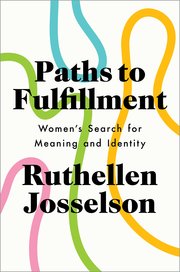Title: Paths to Fulfillment: Women’s Search for Meaning and Identity
Author: Ruthellen Josselson
Publisher: Oxford University Press
Genre: Non-Fiction
Year Published: 2017
Number of Pages: 311
Binding: Hardback
ISBN13: 9780190250393
Price: $29.95
Reviewed by Sarah Moore for the Association for Mormon Letters
When I finished Ruthellen Josselson’s Paths to Fulfillment: Women’s Search for Meaning and Identity, I felt like I had more questions than answers—but I think, perhaps, that is the mark of success in a book that strives to make meaning out of something so complex as identity. I read this book slowly, allowing myself time to breathe between chapters and understand what Josselson was saying not only academically but also personally. In this project Josselson, now a professor of clinical psychology at The Fielding Graduate University, follows the lives of twenty-four women over the course of thirty-five years, from their senior year of college well into their mid-50s. Josselson writes that “to observe a woman’s life is like looking into a kaleidoscope,” and I think she must be right, for although the lives I encountered in this book shifted over the years, they maintained a sort of integrity to the self.
In this book Josselson divides the women she interviews into four personality categories based on Erik Erikson’s stages of development and Jim Marcia’s identity statuses. Josselson renames her groups as Pathmakers, Guardians, Searchers, and Drifters. Each of these categories reflects how the women have sought to form their identities. Pathmakers consciously choose their path, striking away (or against) from their parents to find themselves. Guardians return home, whether physically or psychologically, to protect the values of their upbringing, Searchers are trying to understand who they are, although the answer often eludes them. And Drifters seem the most buffeted by life, unable to form a cohesive identity.
Although, as Josselson admits, these categories frequently blur into each other, they prove to be useful demarcations for understanding the psychological underpinnings of the women encountered, however briefly, in this book. As a group, the Pathmakers were actively involved in shaping their own lives, relying on their self-formed identities to absorb the many challenges they encountered, from career changes, to divorce, to children with disabilities. As Betty says, “I wanted to be my own person … whatever you set your mind to do, it was doable” (44).
Although I admired the Pathmakers, the Guardians were the most familiar to me, surrounded as I am by Mormon women all striving to “keep the faith.” On the whole the Guardians found comfort and strength from the morals of their childhood, although Josselson notes that this often resulted in a kind of rigidity and lack of tolerance in them. This was not, however, always bad, as one Guardian in particular, Emily, ended up becoming the first female federal judge in her court.
The Searchers value “the right to live one’s own life” (160) above all else, although this often fills them with guilt. Millie, the quintessential Searcher, explains that even as she chooses to make her own path, “the more confused I get as to what I want to do with myself” (161). This confusion continues to shadow the Searchers throughout their lives, making them perpetually discontent even with their self-made choices.
I found reading about the Drifters to be the most discouraging, as this is a group that seemed to both encounter the most hardship and be the least equipped to deal with it. Not ever truly having decided who they were, the Drifters were rarely able to consistently keep a job, or a relationship, or even a home. Josselson pointedly addresses the difficulties this group faces, questioning what we can do in the adolescent stage to help this category solidify their identities.
I found myself, as I read this book, pondering what I would say to Josselson if she were to interview me about my life. I reflected on my twenty-one-year-old self, nearly graduated from college and embarking on a mission, full of certainty and conviction. Were my choices, as a convert, those of a Pathmaker? There is, of course, no way for me to truly know, if for no other reason than that we rewrite our perception of our own past through the ensuing decades, as Josselson demonstrates in her interviews with her subjects.
At age 38 I feel more certain about what I would have said to her five years ago, with my youngest and last child toddling around the house as I anticipated starting graduate school after ten years of full-time mothering. I wonder, again, what I will say to my imaginary Josselson five years from now. Will I have gotten a PhD from one of the many programs I am currently applying to? How will I be handling having my first child move out to start college, with another soon to follow? So many questions. Questions, honestly, which I had asked myself before reading this book, but which I now asked with new perspective: how is my identity shaped by the course of my life? Or, as Pathmaker would ask, how do I shape my life through my identity?
Paths to Fulfillment does not answer how to live a fulfilling life. It does, however, illustrate the many varied paths that the women in this book have taken as they have created their own identities, allowing for self-creation in our own lives. As Josselson concludes, “over the course of 35 years, the painting looks different but is clearly the work of the same artist who has a unique style and sensibility” (284).

